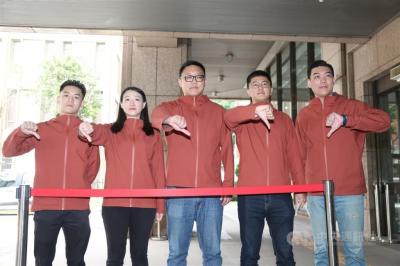The Chinese navy has commissioned three new amphibious transport docks over the past few years that could improve Beijing’s ability to seize and hold Taiwan’s outlying islands.
According to a report to be unveiled by the US House Armed Services Committee yesterday, each of the docks can carry a mix of air-cushion landing craft, amphibious armored vehicles, helicopters and marines.
Nevertheless, the report says that “at this time” China does not appear to be pursuing the amphibious capabilities necessary to conduct a large-scale invasion of Taiwan.
The docks, described as “large amphibious ships,” are part of a general expansion by the People’s Liberation Army Navy (PLA Navy) detailed in the China Economic and Security Review Commission’s recently completed annual report to the US Congress.
A full committee hearing led by representatives Randy Forbes and Colleen Hanabusa is to consider the report, its findings, conclusions and its recommendations.
A draft copy of the report has been the subject of various stories carried by the Taipei Times over the past week.
The report says that the PLA Navy has about 75 major surface combatants, 85 missile patrol boats and 60 conventional and nuclear submarines.
“These units are available for a range of missions — such as enforcing a blockade of Taiwan,” the report says.
“As China’s naval modernization continues, an increasing percentage of these ships and submarines will feature advanced weaponry,” it says.
“In contrast, the Taiwan Navy has 26 major surface combatants, 45 missile patrol boats and two operational submarines,” it adds.
The report says that Taiwan began work on a prototype of a new class of catamaran-style missile corvette in November last year and plans to build up to 11 of them by next year.
“The new ship will carry long-range antiship cruise missiles and feature better sea-keeping ability, range and endurance compared with Taiwan’s current patrol fleet,” the report says.
“In a potential conflict with China, the corvette will enhance the lethality and survivability of Taiwan’s anti-surface force,” it says.
In addition, the report says, Taiwan has deployed its long-delayed Ray Ting (RT)-2000 multiple-launch rocket system.
“In a potential Chinese invasion, the RT-2000 will provide Taiwan with quick-fire capability against Chinese amphibious ships as they cross the Taiwan Strait,” the report says.
“With a range of up to 25 miles [40.2km] and a wheeled chassis allowing for easy maneuverability, the RT-2000 is a significant improvement over its predecessor, the Kung Feng V1,” the report adds.
The Armed Services Committee will hear that Taiwan’s defense spending likely “will remain stagnant” through at least the end of President Ma Ying-jeou’s (馬英九) term in office in 2016.
“President Ma has little incentive to increase the defense budget, since improved cross-strait relations have reduced public perceptions of the China threat in attempts to recover from the global financial crisis,” the report says.
“US officials and outside observers suggest that if this trend continues, then the Taiwan military may struggle to maintain a credible deterrent capability,” it adds.

Taiwan is stepping up plans to create self-sufficient supply chains for combat drones and increase foreign orders from the US to counter China’s numerical superiority, a defense official said on Saturday. Commenting on condition of anonymity, the official said the nation’s armed forces are in agreement with US Admiral Samuel Paparo’s assessment that Taiwan’s military must be prepared to turn the nation’s waters into a “hellscape” for the Chinese People’s Liberation Army (PLA). Paparo, the commander of the US Indo-Pacific Command, reiterated the concept during a Congressional hearing in Washington on Wednesday. He first coined the term in a security conference last

Prosecutors today declined to say who was questioned regarding alleged forgery on petitions to recall Democratic Progressive Party (DPP) legislators, after Chinese-language media earlier reported that members of the Chinese Nationalist Party (KMT) Youth League were brought in for questioning. The Ministry of Justice Investigation Bureau confirmed that two people had been questioned, but did not disclose any further information about the ongoing investigation. KMT Youth League members Lee Hsiao-liang (李孝亮) and Liu Szu-yin (劉思吟) — who are leading the effort to recall DPP caucus chief executive Rosalia Wu (吳思瑤) and Legislator Wu Pei-yi (吳沛憶) — both posted on Facebook saying: “I

The Ministry of Economic Affairs has fined Taobao NT$1.2 million (US$36,912) for advertisements that exceed its approved business scope, requiring the Chinese e-commerce platform to make corrections in the first half of this year or its license may be revoked. Lawmakers have called for stricter enforcement of Chinese e-commerce platforms and measures to prevent China from laundering its goods through Taiwan in response to US President Donald Trump’s heavy tariffs on China. The Legislative Yuan’s Finance Committee met today to discuss policies to prevent China from dumping goods in Taiwan, inviting government agencies to report. Democratic Progressive Party Legislator Kuo Kuo-wen (郭國文) said

Sung Chien-liang (宋建樑), who led efforts to recall Democratic Progressive Party (DPP) Legislator Lee Kun-cheng (李坤城), was released on bail of NT$80,000 today amid outcry over his decision to wear a Nazi armband to questioning the night before. Sung arrived at the New Taipei District Prosecutors’ Office for questioning in a recall petition forgery case last night wearing a red armband bearing a swastika, carrying a copy of Adolf Hitler’s Mein Kampf and giving a Nazi salute. Sung left the building at 1:15am without the armband and covering the book with his coat. Lee said today that this is a serious